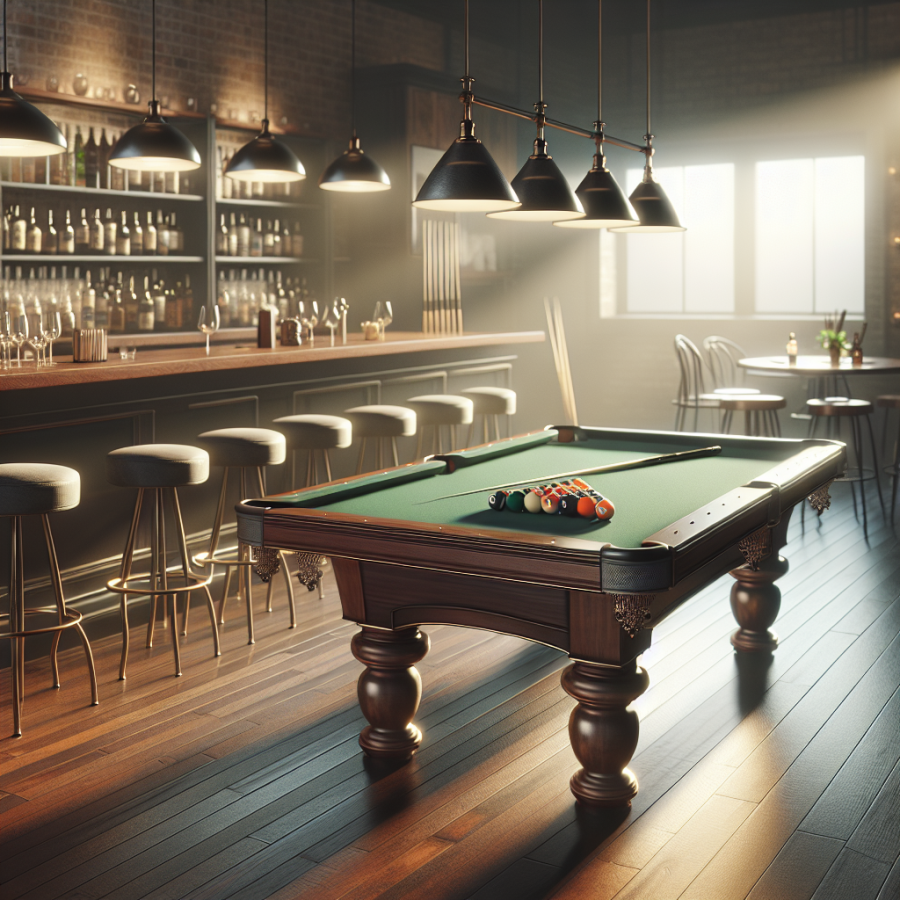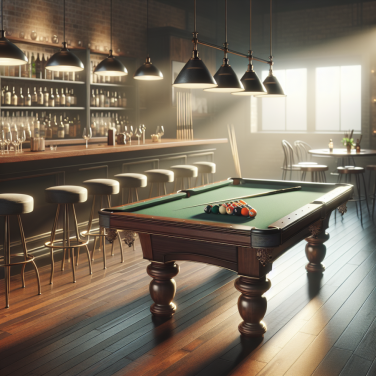Understanding the Rules and Equipment of Bar Billiards
Bar billiards is a cue sport with roots that can be traced back to Belgium or France. Unlike traditional billiards or pool, there's no need for pockets on the table. Instead, holes are sited at one end of the table, within which players must pot balls. The game is played on a small, rectangular table, and the often wooden surface is covered with green baize to create a smooth playing area.
Understanding the rules of bar billiards is essential for any player who wishes to master the game. The primary objective is to score points by potting balls into the holes, which are surrounded by wooden pegs. Each hole on the table has a different point value, typically ranging from 10 to 200 points. The game uses a time limit, and each match typically lasts for either a set period or until a skittle is knocked down, which is positioned on the table to penalize careless shots. Once the time is up or the skittle is knocked over, the game is over and the player with the highest score wins.
It's important to know that the balls can only be shot from the front end of the table and can either be struck directly into the holes or played off one or more cushions. Strategic thinking is crucial; it's often a better play to set up the next shot than to go directly for points, especially if it risks knocking over the skittle and ending the game prematurely.
The equipment used in bar billiards includes a set of seven white balls and one red ball, which often scores double points. The cues used are similar to those used in snooker and pool but may differ slightly in weight and length to accommodate the smaller table size. It's important to select a cue that feels comfortable and well-balanced to enhance precision and control when playing.
Skittles are usually made of wood and are a distinctive feature of bar billiards. They are shaped similar to small bowling pins and are placed at strategic points on the table. Their primary role is to obstruct direct shots to the highest scoring holes and to increase the challenge of the game.
The wooden pegs also play an integral role in bar billiards. They are carefully positioned on the table to make scoring more challenging and to test the players' skill at precision shooting. Hitting a peg can often result in the ball rebounding into an unintended direction, which can either be a stroke of luck or a potential disaster, depending on the context of the game.
Read also:
Secrets of Successful Angling: Tips and Techniques Unveiled
Advanced Techniques and Winning Strategies for Bar Billiards Enthusiasts
Bar billiards, a traditional pub game played on a unique table without pockets, but with holes in the surface and surrounded by pegs, can be mastered through practice and by applying advanced techniques and strategies. Enthusiasts eager to elevate their game will benefit from the following insights and methods.
Firstly, understanding the physics behind shot-making is crucial. Appreciating the way the ball behaves upon contact with another ball, a peg, or the surface of the table can inform your strategy. Employing backspin, or "draw," can pull a ball away from a peg or position the cue ball for your next shot. Likewise, using topspin, or "follow," can drive the cue ball forward after contact with an object ball, potentially positioning it for a subsequent hole.
The tactical selection of shots is another important aspect. High-value holes are tempting, but they're often flanked by pegs, which pose a risk of a "peg out"—hitting a peg, which deducts the score of that shot. Weigh the risk against the potential reward when aiming for such holes, particularly in the later stages of a frame when points are at a premium.
Effective defensive play should not be underestimated. If you're ahead in points and the board presents no obvious safe shots, consider playing into open space to minimize the chance of a peg out or to leave the balls in a challenging position for your opponent. This tactical consideration often separates average players from advanced competitors.
Another winning strategy involves 'sequencing.' The order in which you pot balls to maximize your score involves planning several moves ahead, akin to making strategic plays in chess. Mastering sequencing requires both experience and foresight, allowing you to maintain control over the game and force your opponent to take riskier shots.
Understanding and exploiting the 'balkline rule' can also be advantageous. Knowing when and how to pot the red ball is essential, as the rule stipulates that after a red ball is potted, the next shot must send at least one other ball into a hole or past the balkline to avoid forfeiting the turn. Hence, positioning is key after potting the red ball.
Lastly, ensure consistent practice of difficult shots to increase your confidence during competitive play. This includes practicing angled shots that require precise cue action and challenging sequences that can turn the tide of the game. Developing muscle memory for complex shots ensures that you can execute them under pressure.
Mastering the art of bar billiards requires not only a keen eye and steady hand, but also a strategic mindset. This traditional pub game, which has its origins in billiards, differs because it is generally played on a smaller table and without pockets. Instead, players aim to score points by striking balls into various scoring holes on the table surface.
One crucial strategy in bar billiards is to prioritize your shots. Since different scoring holes offer different points, it is essential to aim for the ones with higher values. However, the risk here is that the higher-scoring holes are typically situated in more challenging locations. This means that a miss could result in your ball ending up in a penalty hole, causing you to lose points.
Another key tip is to work on your cue ball control. Effective positioning of the cue ball after each shot can set you up for subsequent shots, and managing angles can be the difference between a winning streak and a clumsy foul. Be mindful of the ‘diddle'—the bar in the center of the table—since a cue ball interfering with it can end your turn prematurely.
Many players overlook the importance of defense in bar billiards, but smart players use it to their advantage. For instance, blocking an opponent's path to a high-scoring hole can force them into a difficult shot, increasing their chances of making a mistake. Simultaneously, positioning your own balls to protect your scoring zones can limit their options, nudging the game in your favor.
Psychological strategies are also at play in the bar billiards game. It's important to remain calm and composed, regardless of the pressure. Even if you execute a poor shot, maintaining a steady demeanor can prevent you from losing focus and can also prevent your opponent from gaining a psychological edge.
Let's not forget the practice factor—refining your skills in different scenarios is vital. Whether it's shooting from awkward angles, practicing touch shots for precise cue ball positioning, or developing a consistent stroke, spending time on these aspects will pay dividends when it's game time.
Finally, game etiquette and sportsmanship go a long way in bar billiards. Respectful conduct toward your opponents and adherence to the rules enhance the enjoyment for everyone and foster an environment where skill and fair play are paramount.
By concentrating on these tactics and continually polishing your skills, you can evolve from a casual player to a formidable bar billiards competitor.




